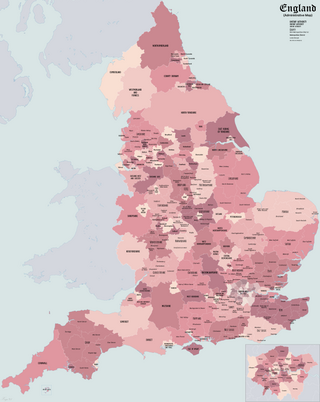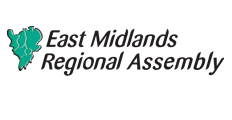Related Research Articles

The subdivisions of England constitute a hierarchy of administrative divisions and non-administrative ceremonial areas.

Thames Gateway is a term applied to an area around the Thames Estuary in the context of discourse around regeneration and further urbanisation. The term was first coined by the UK government and applies to an area of land stretching 70 kilometres (43 mi) east from inner east and south-east London on both sides of the River Thames and the Thames Estuary. It stretches from Westferry in Tower Hamlets to the Isle of Sheppey/Southend-on-Sea and extends across three ceremonial counties.

The regional chambers of England were a group of indirectly elected regional bodies that were created by the provisions of the Regional Development Agencies Act 1998. There were eight regional chambers, one for each of the regions of England except Greater London, which had opted for an elected mayor and assembly in 1998. All eight regional chambers had adopted the title "regional assembly" or "assembly" as part of their name, though this was not an official status in law. The chambers were abolished over a two-year period between 31 March 2008 and 31 March 2010 and some of their functions were assumed by newly established local authority leaders' boards.

The Learning and Skills Council (LSC) was a non-departmental public body jointly sponsored by the Department for Business, Innovation and Skills (BIS) and the Department for Children, Schools and Families (DCSF) in England. It closed on 31 March 2010 and was replaced by the Skills Funding Agency and the Young People's Learning Agency.

Southampton City Council is the local authority of the city of Southampton. It is a unitary authority, having the powers of a non-metropolitan county and district council combined. It provides a full range of local government services including council tax billing, libraries, social services, processing planning applications, waste collection and disposal, and it is a local education authority. The council uses a leader and cabinet structure. Labour has been in control of the council since 2022.
City region is a term in use since about 1950 by urbanists, economists and urban planners to mean a metropolitan area and hinterland, often having a shared administration. Typically, it denotes a city, conurbation or urban zone with multiple administrative districts, but sharing resources like a central business district, labour market and transport network such that it functions as a single economic unit

In the United Kingdom, regional development agencies (RDAs) were nine non-departmental public bodies established for the purpose of development, primarily economic, of England's Government Office regions between 1998 and 2010. There was one RDA for each of the NUTS level 1 regions of England. Similar activities were carried out in Wales by the Welsh Government Department of Economy and Transport, in Northern Ireland by the Department of Enterprise, Trade and Investment and in Scotland by Scottish Enterprise and Highlands and Islands Enterprise.
English Partnerships (EP) was the national regeneration agency for England, performing a similar role on a national level to that fulfilled by regional development agencies on a regional level. On 1 December 2008 its powers passed to a successor body, the new Homes and Communities Agency.

Liverpool City Region is a mayoral combined authority in North West England.

The East of England Regional Assembly was the regional chamber for the East of England region of the England. It was based at Flempton, near Bury St Edmunds in Suffolk. The assembly was created as a voluntary regional chamber in 1998 by the Regional Development Agencies Act 1998. The first meeting was held in March 1999. In July 2003 the assembly was reconstituted to combine its existing functions with those of the regional arm of the Local Government Association and of the Regional Employers Organisation. The assembly was abolished on 31 March 2010, its functions transferring to the newly constituted East of England Local Government Association.

The East Midlands Regional Assembly was the regional chamber for the East Midlands region of the England. It was based at Melton.
South East England Regional Assembly (SEERA) was the regional chamber for the South East England region. Regional Chambers were established by the Regional Development Agencies Act 1998 and their function of consultation was shown in Section 8 of the Act. It was based at Guildford until it was dissolved on 31 March 2009, with its functions being assumed by the South East England Partnership Board, which comprises members of SEEDA board, the Regional Development Agency and the South East England Leaders’ Board, the executive body of South East England Councils.
Yorkshire and Humber Assembly was the regional chamber for the Yorkshire and the Humber region of England. It closed on 31 March 2009. The responsibilities of the assembly were assumed by a joint regional board consisting of members of Yorkshire Forward, the regional development agency, and Local Government Yorkshire and Humber, a regional partnership of local authorities.

Local authority leaders' boards are voluntary regional associations of council leaders that have been established in England outside of Greater London to replace certain functions of the now abolished regional chambers. The establishment of the boards was part of the UK Government's Review of Sub-National Economic Development and Regeneration. which brought forward the Government's plans to alter the structure of regional governance in England and was mandated by the Local Democracy, Economic Development and Construction Act 2009. In June 2010, the new Conservative-LibDem coalition government announced plans to remove funding from the new boards and to remove their statutory functions. It was indicated that the boards might continue as voluntary associations of council leaders.

The regions of England, formerly known as the government office regions, are the highest tier of sub-national division in England. They were established in 1994 and follow the 1974–96 county borders. They are a continuation of the former 1940s standard regions which followed the 1889–1974 administrative county borders. Between 1994 and 2011, all nine regions had partly devolved functions; they no longer fulfil this role, continuing to be used for limited statistical purposes.

The Leeds City Region, or informally Greater Leeds, is a local enterprise partnership city region located in West Yorkshire, England. Prior to the West Yorkshire devolution deal, the partnership covered parts of South and North Yorkshire. According to the Office for National Statistics, as of 2017 the city region ranked 2nd behind Greater London for both population and GVA in the United Kingdom. It has a population of 2,320,214 million and a GVA of £69.62 billion.
In England, local enterprise partnerships (LEPs) are voluntary partnerships between local authorities and businesses, set up in 2011 by the Department for Business, Innovation and Skills to help determine local economic priorities and lead economic growth and job creation within the local area. They carry out some of the functions previously carried out by the regional development agencies which were abolished in March 2012. In certain areas, funding is received from the UK government via growth deals.

The West Yorkshire Combined Authority (WYCA) is the combined authority for West Yorkshire in England. It was established by statutory instrument under the Local Democracy, Economic Development and Construction Act 2009 on 1 April 2014. It is a strategic authority with powers over transport, economic development and regeneration. The metro-mayor of the authority is Tracy Brabin.
The history of local government in Sussex is unique and complex. Founded as a kingdom in the 5th century, Sussex was annexed by the kingdom of Wessex in the 9th century, which after further developments became the Kingdom of England. It currently corresponds to two counties, East Sussex and West Sussex.

Regional economy in Wales is centred on four regional economic boards in Wales. Each board oversees a city or growth deal, signed between 2016 and 2022, lasting 10–15 years. Two of the deals are city deals signed and proposed by their respective economic boards, and their areas are described as "city regions"; the Cardiff Capital Region and Swansea Bay City Region. Whereas in North Wales, the North Wales Economic Ambition Board negotiated a North Wales growth deal signed in 2020, and in Mid Wales, the Growing Mid Wales Partnership, led negotiations for a Mid Wales growth deal signed in 2022. The programmes are based on the City deal and Growth deal initiatives set up by the Coalition UK Government in 2012, to promote the decentralisation of the UK economy, by stimulating local economic growth.
References
- ↑ EEDA - EEDA's budget Archived 2008-12-18 at the Wayback Machine
- ↑ "Archived copy". Archived from the original on 27 September 2007. Retrieved 13 November 2008.
{{cite web}}: CS1 maint: archived copy as title (link)